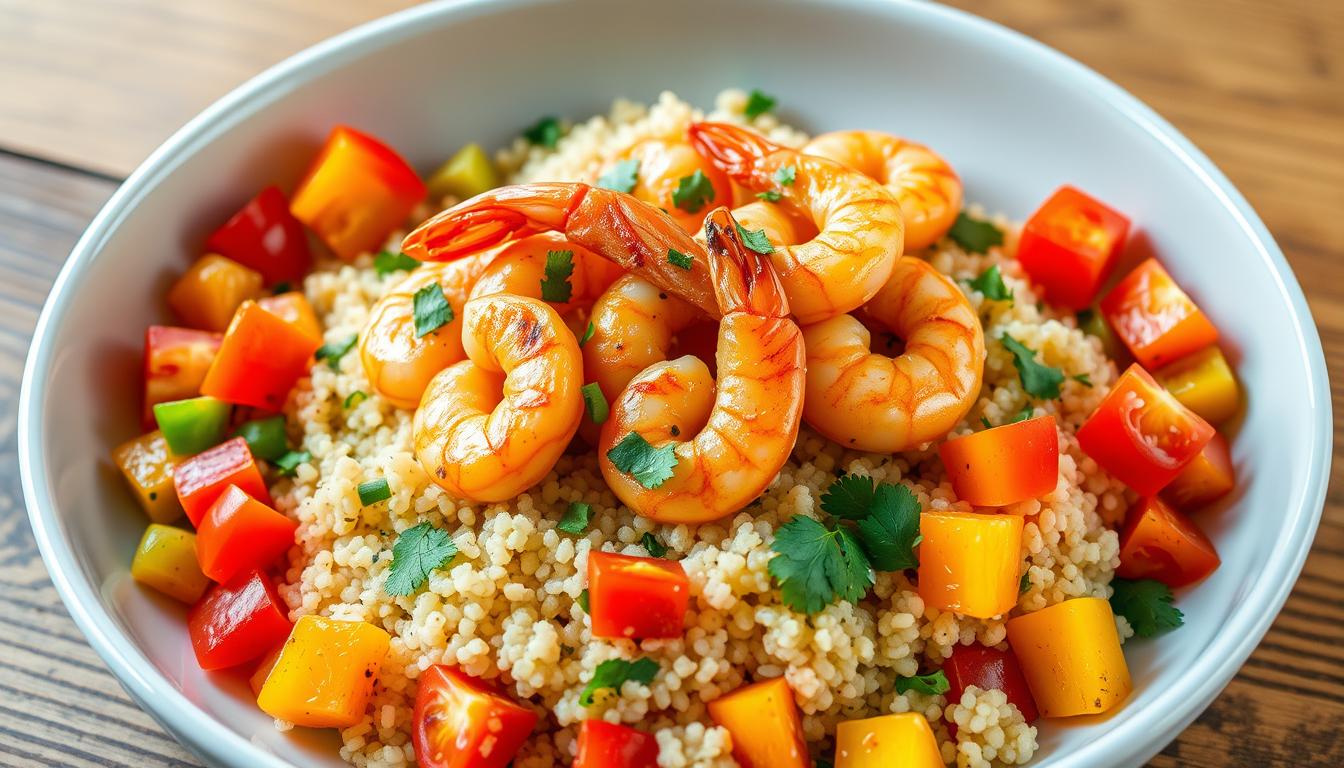Do you live with the pain of fibromyalgia? You’re not alone. This condition affects about 4 million adults in the U.S., causing chronic pain. But, there’s a tasty recipe that might help. It’s Sautéed Shrimp with Quinoa, packed with nutrients like omega-3s, gluten-free protein, and low-glycemic carbs.
This dish is not just yummy but also good for your body. Shrimp is a lean protein with lots of omega-3s. Quinoa, on the other hand, is gluten-free and low on the glycemic index. It helps keep blood sugar stable and fights inflammation.
Want to know how this meal can help with fibromyalgia? Let’s explore the benefits of Sautéed Shrimp with Quinoa.
What is Fibromyalgia?
Fibromyalgia is a chronic condition that causes muscle pain, fatigue, and sleep disturbances. It affects about 4 million adults in the U.S. The exact cause is not known, but genetics and environment play a role.
This condition is long-lasting and needs ongoing care. It makes daily tasks hard and limits an active lifestyle. People with fibromyalgia often struggle to live a normal life.
Common Fibromyalgia Symptoms
- Widespread Muscle Pain: People with fibromyalgia feel constant pain or burning in their muscles and joints.
- Fatigue: They are extremely tired and lack energy, making simple tasks hard.
- Sleep Disturbances: It’s hard for them to fall asleep, stay asleep, or get good sleep.
- Cognitive Difficulties: They often have trouble with memory, concentration, and mental clarity, known as “fibro fog.”
- Sensitivity to Pain: They feel more pain from touch, pressure, and temperature changes.
Managing fibromyalgia symptoms requires a variety of approaches. This includes diet changes, exercise, stress management, and working with healthcare providers. Exploring self-care strategies can also help improve their quality of life.
Dietary Approaches for Fibromyalgia
Research shows that certain diets can help manage fibromyalgia symptoms. Low-calorie diets, vegetarian diets, and low FODMAP diets are promising. They may reduce pain and other symptoms by reducing inflammation and promoting weight loss.
Low-Calorie Diets
Low-calorie diets focus on whole, nutrient-dense foods. They help with weight loss, which can ease body strain and reduce inflammation. By eating lean proteins, vegetables, and healthy fats, you can improve your health and possibly your fibromyalgia symptoms.
Vegetarian Diets
A vegetarian diet eliminates meat and focuses on plants. It can lower inflammation and provide essential nutrients. But, make sure to get enough protein, iron, and vitamin B12 on a vegetarian diet.
Low FODMAP Diets
The low FODMAP diet helps by avoiding foods that cause stomach issues. This is common in fibromyalgia. By avoiding these foods, you can manage digestive problems and possibly lessen symptoms.
Trying one or more of these diets, along with lifestyle changes, can help manage fibromyalgia. Always talk to a healthcare professional before changing your diet to make sure it’s right for you.
Anti-Inflammatory Foods for Fibromyalgia
If you have fibromyalgia, eating anti-inflammatory foods can help. Chronic inflammation is thought to cause this condition. So, eating foods that fight inflammation can help a lot.
Some great anti-inflammatory foods include salmon, eggs, and chickpeas. Also, fruits, vegetables, whole grains, healthy fats, and spices like turmeric, ginger, and garlic are good choices.
- Almonds have anti-inflammatory properties that may help with rheumatoid arthritis.
- Apple cider vinegar can aid in digestive health, helping with spastic colon and gastroenteritis.
- Apricots are anti-inflammatory fruits with lots of phytochemicals like quercetin, which are antioxidants.
- Asparagus is a prebiotic that supports gut health and immune function.
- Avocados are full of healthy fats, which can help with weight loss and inflammation.
| Anti-Inflammatory Food | Potential Benefits |
|---|---|
| Basil, Parsley, Rosemary | Offer both flavor enhancement and anti-inflammatory properties. |
| Bell Peppers | Contain flavonoids that provide antioxidant support in combating inflammation, offer weight loss benefits and protect against free radical damage. |
| Beans (Black Beans) | High in fiber and ideal for weight management, contributing to an anti-inflammatory diet. |
Eating these anti-inflammatory foods is a big step towards managing your fibromyalgia symptoms. It helps reduce the chronic inflammation that may be causing your condition.
Sautéed Shrimp with Quinoa for Fibromyalgia
If you have fibromyalgia, this sautéed shrimp with quinoa dish might change your life. It’s packed with anti-inflammatory omega-3 fatty acids, gluten-free protein, and low-glycemic carbohydrates. These nutrients are great for managing your symptoms.
This recipe makes 4-6 servings, perfect for a small group. It includes red quinoa, lime juice, cumin, and more. Cooking the quinoa takes just 15 minutes. You can also use chipotle Tabasco instead of chipotle powder if you don’t have it.
Many studies back the health benefits of this dish. Vitamin C in lime juice and peppers can lower heart disease risk. Quinoa’s fiber supports gut health and fights inflammation. The omega-3 fatty acids in shrimp and olive oil’s anti-inflammatory effects make it a nutrient-dense meal for fibromyalgia sufferers.
As Jaynerly said, this recipe is “flavorful, healthy, and quick to make.” It’s a great choice for a main dish or side. This sautéed shrimp with quinoa will likely become a favorite in your kitchen.
Benefits of Shrimp for Fibromyalgia
If you have fibromyalgia, adding shrimp to your meals can make a big difference. Shrimp is low in fat but high in protein and omega-3 fatty acids. These are good for your health and can help with fibromyalgia symptoms.
Lean Protein for Muscle Health
Fibromyalgia often causes muscle pain and tenderness. Shrimp is a lean protein that’s good for your muscles. It has less fat and calories than other proteins, helping your muscles recover and repair.
Anti-Inflammatory Omega-3s
Shrimp is also packed with omega-3 fatty acids, which fight inflammation. This can help reduce pain and other symptoms of fibromyalgia.
| Nutrient | Amount in Shrimp (per 3 oz serving) |
|---|---|
| Protein | 20 grams |
| Omega-3 Fatty Acids | 0.3 grams |
| Selenium | 48 micrograms |
| Vitamin B12 | 0.9 micrograms |
Shrimp also has selenium and vitamin B12, which are good for your health. These nutrients can help improve your overall well-being if you have fibromyalgia.
Adding shrimp to your diet can help manage fibromyalgia symptoms. It supports your health and wellness in many ways.
Quinoa: A Fibromyalgia-Friendly Grain
If you have fibromyalgia, adding quinoa to your meals can make a big difference. This fibromyalgia-friendly grain is packed with nutrients that help manage your symptoms.
Quinoa is gluten-free and has a low glycemic index. It gives you energy without causing blood sugar spikes. This is important because spikes can make fibromyalgia symptoms worse. Quinoa is also full of fiber, protein, and vitamins and minerals that boost your health.
- It’s high in magnesium, which fights inflammation and helps with muscle pain and fatigue.
- It’s a good source of B vitamins, which are key for energy and nerve health.
- It has tryptophan, which helps you sleep better, a big challenge for fibromyalgia patients.
Try the Sautéed Shrimp with Quinoa recipe to see how it can help. Quinoa is versatile, so find dishes you like to make it a part of your diet.
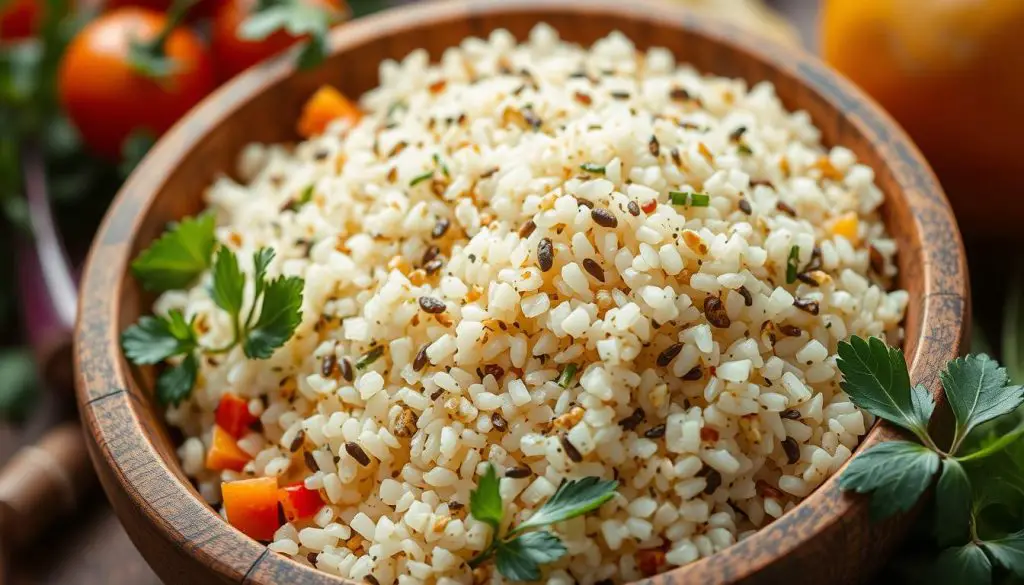
For fibromyalgia, eating a balanced diet is essential. Quinoa is a great choice because it’s fibromyalgia-friendly and delicious.
Preparing Sautéed Shrimp with Quinoa
To make a tasty and healthy sautéed shrimp with quinoa dish, just follow a few easy steps. First, cook the quinoa as the package says. This grain is great for a fibromyalgia-friendly meal because it’s gluten-free and full of protein and complex carbs.
Sautéing the Shrimp
In a big skillet, heat some olive oil over medium-high. Add the [sautéed shrimp] and cook until they’re done, about 3-5 minutes. Don’t forget to season them with salt and pepper for extra flavor.
Then, add minced garlic and diced onions to the skillet. Cook them until they smell good and the onions are clear, about 2-3 minutes. This will make your [cooking quinoa] taste amazing.
After the shrimp and veggies are cooked, mix them with the quinoa. You can also add more seasonings or fresh herbs like parsley or cilantro for extra taste.
By following these simple [recipe instructions], you can make a nutritious and fulfilling sautéed shrimp with quinoa meal. It’s great for managing fibromyalgia symptoms. This dish is full of anti-inflammatory nutrients and has a good mix of protein, complex carbs, and healthy fats for your health.
Nutrition Profile of Sautéed Shrimp with Quinoa
The sautéed shrimp with quinoa recipe is a great choice for those with fibromyalgia. It has a balanced nutrition profile. It includes lean protein, complex carbohydrates, and healthy fats.
The shrimp in this dish is a lean protein source. It has a high-quality amino acid profile. Quinoa, the gluten-free grain, is a complex carbohydrate. It gives sustained energy and has a low-glycemic response, making it perfect for those with fibromyalgia.
This dish is also packed with various micronutrients that support overall health. These include:
- Omega-3 fatty acids from the shrimp, which have anti-inflammatory properties
- Vitamins and minerals, such as vitamin B12, magnesium, and zinc, which are essential for energy production and immune function
- Antioxidants from the herbs and spices used in the dish, which can help reduce oxidative stress
The balanced nutrition profile of this sautéed shrimp with quinoa recipe is great for those managing fibromyalgia. Adding this dish to their meals can provide a delicious and nutritious option. It may help manage their symptoms.
| Nutrient | Amount per Serving |
|---|---|
| Calories | 400 |
| Protein | 32g |
| Carbohydrates | 40g |
| Fat | 15g |
| Omega-3 Fatty Acids | 1.5g |
| Vitamin B12 | 2.5mcg |
| Magnesium | 150mg |
| Zinc | 3mg |
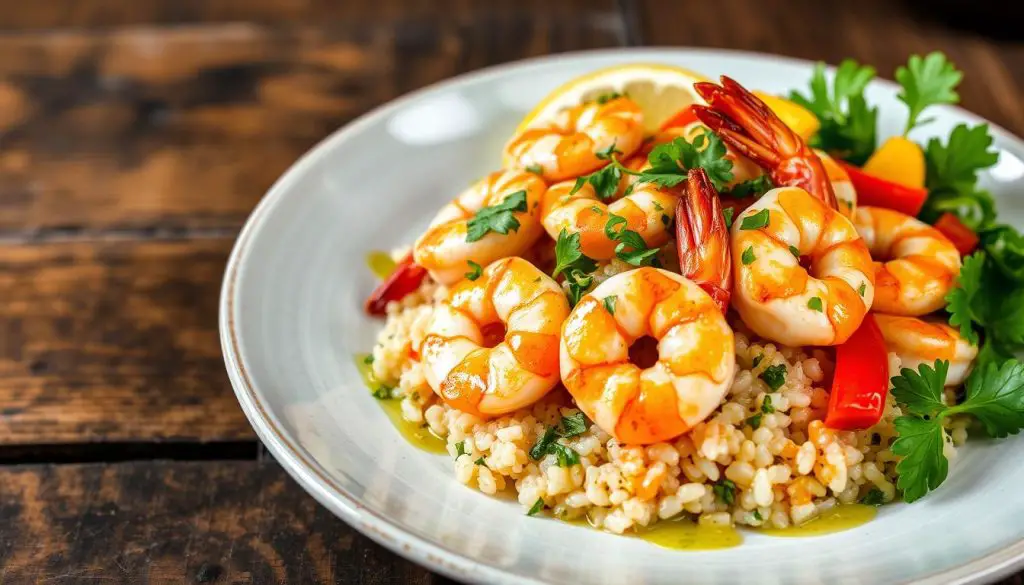
Lifestyle Modifications for Fibromyalgia
Living with fibromyalgia means more than just what you eat. You can also manage symptoms by exercising regularly, managing stress, and sleeping well. These steps help you tackle fibromyalgia management and symptom relief from all angles.
Exercise is key for chronic pain in fibromyalgia. Try low-impact activities like walking, swimming, or yoga. These improve strength, flexibility, and mood. They also help reduce stress, which is a big part of fibromyalgia.
Managing stress is vital for lifestyle modifications in fibromyalgia. Use deep breathing, meditation, or mindfulness to lower stress. These methods can greatly help with fibromyalgia symptoms.
Getting enough sleep is also critical. Poor sleep can make pain and fatigue worse. Try a regular sleep schedule, good sleep habits, and insomnia therapy to improve sleep.
Combine diet changes, exercise, stress management, and good sleep for a holistic approach to fibromyalgia management. This can help reduce chronic pain and other symptoms. A plan that fits your needs is essential for managing this complex condition.
Holistic Approach to Fibromyalgia Management
Managing fibromyalgia well means looking at all parts of the condition. This includes changing your diet, exercising, managing stress, and using medicine if needed. These steps can help reduce symptoms and improve life quality.
Diet for Fibromyalgia
A diet low in carbs, high in fiber, protein, and moderate is best for fibromyalgia. Avoid foods like pasta, bread, and pastries that can make pain worse. Focus on whole foods rich in nutrients. Also, fixing nutrient gaps, like magnesium and vitamin D, can ease muscle pain.
Exercise and Stress Management
- Low-impact activities like walking, swimming, or gentle yoga can boost strength and flexibility.
- Stress-reducing practices, like meditation, can lessen fibromyalgia’s emotional toll.
Medication and Supplements
At times, medicine or supplements are needed to control symptoms. Your doctor will decide the best treatment, which might include pain relievers or supplements like magnesium and vitamin D.
By using a holistic approach that includes diet, exercise, stress management, and medicine, you can manage fibromyalgia better. This way, you can improve your overall health and well-being.
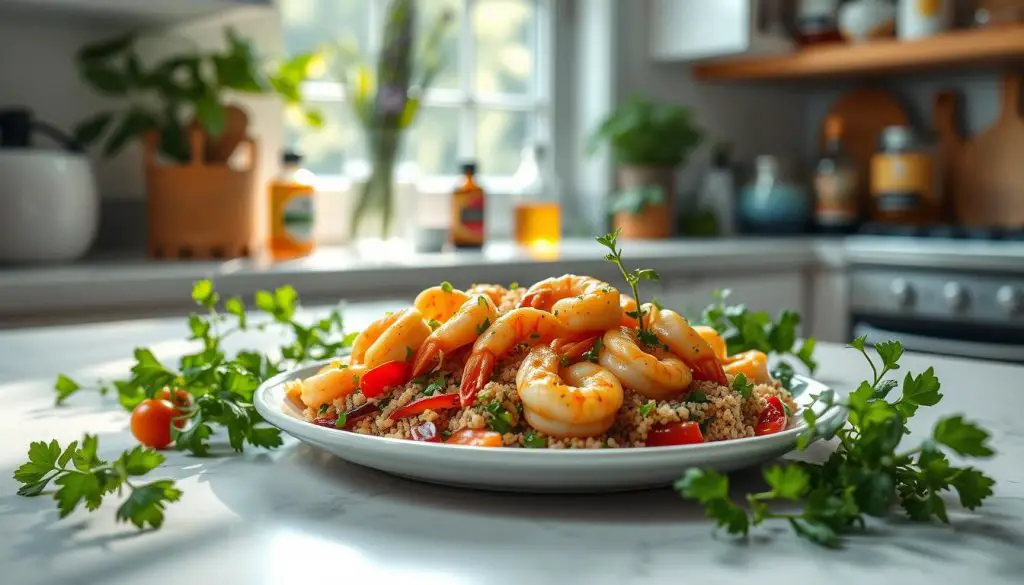
Other Fibromyalgia-Friendly Recipes
There are many fibromyalgia-friendly recipes you can try. These include anti-inflammatory dishes, low-calorie meals, vegetarian options, and low FODMAP recipes. They can help manage fibromyalgia symptoms.
A anti-inflammatory meal could be roasted veggies like bell peppers, onions, and garlic. Add a protein like baked salmon or grilled tofu. Using low-calorie ingredients like quinoa and leafy greens is also good. Try a low FODMAP veggie stir-fry with bok choy and tempeh for a vegetarian option.
| Recipe | Key Features | Cooking Time |
|---|---|---|
| Roasted Vegetable and Quinoa Bowl | Anti-inflammatory, low-calorie, vegetarian | 45 minutes |
| Grilled Salmon with Avocado Salsa | Anti-inflammatory, low FODMAP | 30 minutes |
| Lentil and Kale Soup | Anti-inflammatory, low-calorie, vegetarian | 1 hour |
Trying different fibromyalgia-friendly recipes can make your diet more varied and healthy. Listen to your body and adjust recipes to meet your needs.
Tips for Following a Fibromyalgia Diet
Starting a fibromyalgia-friendly diet can be tough but rewarding. To ease the transition, plan meals ahead, buy the right groceries, and cook in bulk. Getting help from a registered dietitian can also be key in creating a diet plan that works for you.
Here are some tips to help you follow a fibromyalgia diet successfully:
- Meal Planning: Spend time planning your meals and snacks for the week. This keeps you organized and ensures you have what you need.
- Grocery Shopping: Create a detailed grocery list and stick to it. This helps avoid buying things that aren’t good for fibromyalgia.
- Food Preparation: Set aside time to prepare meals in bulk. This makes it easier to have healthy food options all week.
- Hydration: Drink lots of water and limit sugary or caffeinated drinks. These can make fibromyalgia symptoms worse.
- Avoiding Triggers: Find and avoid foods that make your symptoms worse. It might take some trial and error.
- Seek Professional Guidance: Work with a registered dietitian who knows about fibromyalgia. They can help make sure you’re eating a balanced diet.
By following these tips, you can make following a fibromyalgia diet easier. This increases your chances of managing your symptoms better.
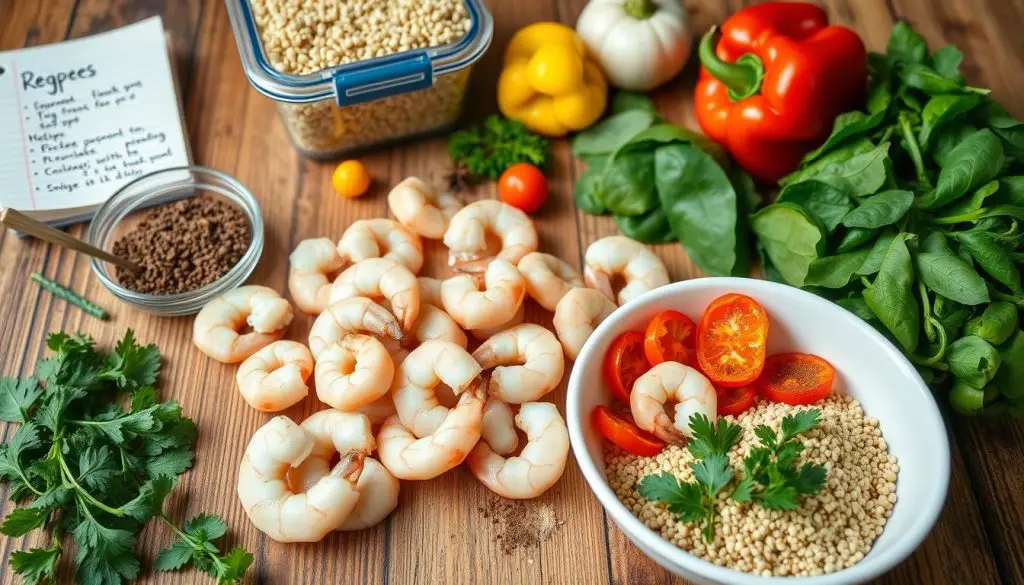
Managing Fibromyalgia Flare-Ups with Diet
When you’re having a fibromyalgia flare-up, what you eat can really help. Eating foods that fight inflammation, drinking plenty of water, and getting enough nutrients can make a big difference. These steps can help lessen the pain and support your body’s healing.
Studies show that a diet low in carbs, high in fiber, protein, and moderate in fat works well for fibromyalgia. Foods packed with magnesium, like spinach and avocados, can help with muscle pain.
For pain relief, try foods rich in selenium, such as mushrooms and eggs. Vitamin D, found in seafood and sunlight, also helps. B vitamins in foods like spinach and almonds are key for managing pain.
Adding detox foods like cilantro and green tea to your diet can help remove toxins that cause pain. A diet full of veggies, lean meats, and lentils, along with warm lemon water and green tea, can help reduce pain.
By eating anti-inflammatory foods and drinking enough water, you can better manage fibromyalgia flare-ups. A balanced diet, along with other lifestyle changes, is a powerful way to manage your fibromyalgia.
Resources for Fibromyalgia Support
If you’re living with fibromyalgia, you’re not alone. There are many resources to help you manage your condition and find support. Organizations like the Fibromyalgia Association of America offer educational materials and support groups. They also work to raise awareness about fibromyalgia.
Online communities are another great place to find support. People with fibromyalgia share their experiences and offer advice. These communities can make you feel less alone and more empowered.
Your healthcare providers are also important. They can help you create a treatment plan that fits your needs. This ensures you get the best care possible.
Source Links
- https://www.healthline.com/health/rheumatoid-arthritis/seven-day-meal-plan
- https://www.fibrofix.com/pages/21-day-detox
- https://www.drtereo.com/blog/recipes-for-health-
- https://www.acufinder.com/Acupuncture Information/Detail/Food as Medicine for Fibromyalgia
- https://www.webmd.com/diet/foods-high-in-nickel
- https://www.healthline.com/nutrition/pegan-diet
- https://www.thehouseofacupuncture.co.nz/spleen-diet-gut-health-digestion-chinese-medicine-acupuncture
- https://www.mobeforlife.com/resources
- https://healthwholeness.com/nutrition/anti-inflammatory-foods/
- https://www.eatingwell.com/30-minute-anti-inflammatory-chicken-dinner-recipes-8606692
- https://food52.com/recipes/2364-spicy-black-bean-and-quinoa-salad
- https://poshjournal.com/ancient-grains-kaniwa-salad
- https://inspiralized.com/romesco-garlic-shrimp-with-zucchini-noodles/
- https://www.aol.com/20-healthy-dinner-bowl-ideas-174106220.html
- https://www.aol.com/see-white-stuff-salmon-means-123701504.html#!
- https://www.healthline.com/nutrition/mediterranean-diet-meal-plan
- https://www.arthritisfoundationasia.com/arthritis-friendly-recipes.html
- https://sustainabledish.com/defense-real-food-paleo-whole30-dietitian-responds-us-news-world-reports-best-diets-2017/
- https://library.sarahbush.org/Library/Recipes/Category/PorkVeal/Recipes.pg?topicid=23781
- https://wellnessmama.com/health/autoimmune-diet/comment-page-1/
- https://www.healthline.com/health/managing-osteoporosis/7-day-osteoporosis-diet-plan
- https://www.health.com/fodmap-diet-7970881
- https://manciniacupuncture.com/resources/articles/
- https://wholehealthchicago.com/blog/2010/04/01/allergy-elimination-diet
- https://lilynicholsrdn.com/first-week-of-my-leap-diet/
- https://www.nationwidechildrens.org/family-resources-education/family-resources-library?sw=i,j&pg=all
- https://www.spectrumhealthlakeland.org/lakeland-comprehensive-medical-weight-loss-center/health-library/Encyclopedia/22/
- https://the-doctors-note.ca/2015/05/16/recipes-index/
